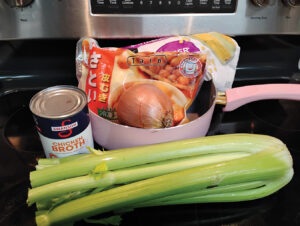I “invented” this kalo (taro) chowder during the COVID shutdown, a time when we were trying to support the local farmers who were struggling to move their produce. My daughter knows a farmer who gave us a lot of his kalo. At one point, we had so much, I had to find a creative way to use it all!
I found a corn-potato chowder recipe and substituted kalo in place of the potato. All the veggies can be locally sourced at your local farmers’ market. Get two raw kalo (taro) roots about the size of your fist. Pressure cook them for 45 minutes, then peel off the skin when the kalo is cool enough to handle. Or, you can find kalo in supermarkets in the frozen food section packaged in 12-ounce bags (pictured above), already cooked, cleaned and ready to use.
I experimented using different amounts of salt and spices… a little of this and a little of that. I think this final recipe is the best. It’s a great chowder for those cold Hawai‘i winter days!
Ingredients
1 small/med. yellow onion (chopped fine)
1 celery stalk (chopped)
1 clove garlic (diced)
½ Tbsp. olive oil
½ tsp. table salt or Hawaiian salt
½ tsp. ground thyme
¼ tsp. coarse ground pepper
2 cups chicken broth
2 cups corn, fresh or canned
1-1/2 cups kalo root (chopped in small cubes)
3/4 cup milk
2 Tbsp. corn starch
Directions
In in a large soup pot, sauté the onion and celery in the olive oil. Stir in the garlic but don’t brown it. Add the spices and stir constantly while adding the broth. Bring to a slow simmer, then add the corn and kalo cubes. Simmer for 20 minutes. Mix cornstarch and milk until smooth, then add it to the corn and kalo pot. Continue simmering for 20 minutes or until thickened. Prep and cooking time: under one hour.
Serves: 4
Do you have a favorite recipe and story to share? For consideration in the next issue, include a photo and mail them to Generations Recipe, PO Box 4213, Honolulu, HI96812, or email them to Cynthia@generations808.com.
KALO CHOWDER RECIPE NOTE: Make it vegan by using vegetable broth instead of chicken broth and almond milk instead of milk.



Leave a Reply